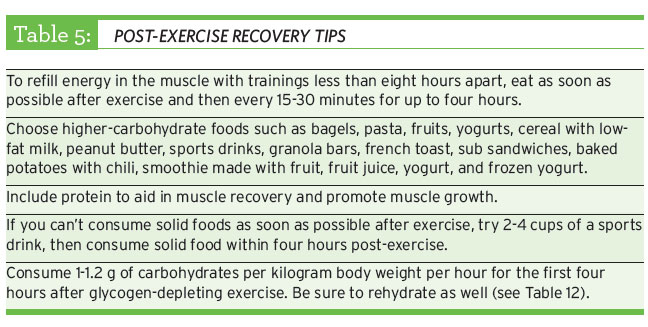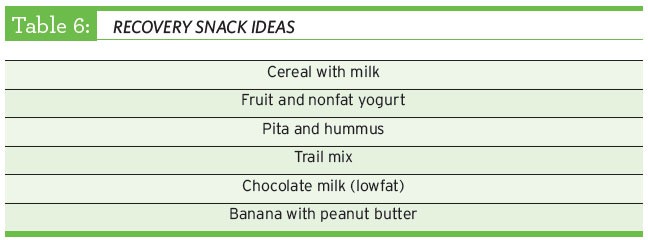Carbohydrates
The Master Fuel
A diet rich in carbohydrates increases both endurance and intermittent high-intensity performance because of the extra store of carbohydrates in the muscles and liver, called glycogen. It is well documented that athletes need to replenish carbohydrate stores in the body, especially during periods of intense training or competition. Consuming carbohydrates during workouts lasting over one hour can also benefit performance and delay onset of fatigue. Studies have shown that athletes who participate in intermittent sports, such as basketball and soccer, should also focus on consuming more carbohydrates during training and competition. This is not surprising since it is well-known that carbohydrates, when compared to protein and dietary fat, are the most efficiently broken down and metabolized form of energy for the body.
As Early as the 1930s, scientists observed that endurance exercise could be improved by increasing carbohydrates in the diet.
-fyi-
(focus on your intake)
RECOMMENDED INTAKE OF CARBOHYDRATES
Depending upon the training routine, athletes should consume anywhere from 3-12 grams of carbohydrates per kilogram of bodyweight throughout the day. This percentage is only a guideline for estimating carbohydrate needs. Depending upon the length and type of training sessions, an athlete’s carbohydrate intake should adjust, with longer times and more intense trainings reflecting the higher number of grams needed.
Table 1 Determining Grams of Carbohydrates for Athletes Needs
The following example shows how to calculate the recommended grams of carbohydrates needed per pound of body weight.

IMAGE TEXT:
Now calculate your own needs. Remember to divide your body weight in pounds by 2.2 to get your weight in kilograms. Then multiply your body weight by a number of carbohydrate grams based on the time and intensity of the training. For example, an hour per day of moderate intensity exercise may warrant using 5 grams.
Carbohydrate Intake Before, During, and After Exercise
Before Exercise
The pre-exercise or pre-training meal serves two purposes:
- It keeps the athlete from feeling hungry before and during exercise, and
- It maintains optimal levels of energy for the exercising muscles.
Athletes who train early in the morning, before eating or drinking, should ensure the previous night’s meal contains adequate carbohydrates and then consume about 30 grams of well tolerated carbohydrates five minutes prior to training to help maintain blood glucose and muscle glycogen levels. Blood glucose, the sugar found in the blood, is the energy delivered to the working muscles and organs, along with muscle glycogen, that allows your body to complete activity.
Carbohydrate intake before and after exercise can help to restore sub-optimal glycogen stores, which is critical for prolonged periods of exercise. While allowing for personal preferences and physiological factors, the pre-event meal should be high in carbohydrates, non-greasy, and readily digestible. Fatty foods should be limited as they delay the emptying time of the stomach and take longer to digest. The following are guidelines for the pre-event meal:
- The meal should be eaten 3-4 hours before an event.
- It should provide 3-4 grams of carbohydrates per kilogram of body weight.
- To avoid stomach upset, the carbohydrate content of meals should be reduced the closer the meals are to the event. (1-2 grams per kilogram 1-2 hours before the event).
- Adding small amounts of protein can aid in regulating energy levels by slowing down carbohydrate absorption, delivering the carbohydrates to the working muscles at a more consistent rate over time.
- Pay attention to salty cravings. If competing in hot/humid climates, make sure to replace electrolyte losses with salty snack foods, such as pretzels or sport drinks with added sodium.
[For example, four hours before the event, it is suggested that the athlete consume 1.5 grams of carbohydrates per pound of body weight, whereas one hour before the competition, the athlete would consume 0.5 grams of carbohydrates per pound of body weight.]
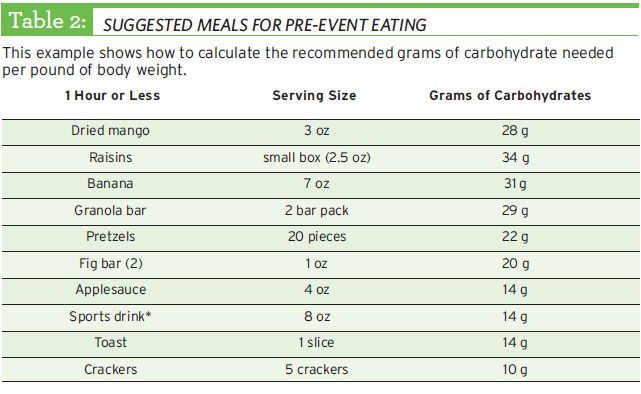
TABLE 2 IMAGE TEXT:
SUGGESTED MEALS FOR PRE-EVENT EATING.
This example shows how to calculate the recommended grams of carbohydrate needed per pound of body weight.
| 1 Hour or Less | Serving Size | Grams of Carbohydrates |
|---|---|---|
| Dried Mango | 3 oz | 28 g |
| Raisins | small box (2.5 oz) | 34 g |
| Banana | 7 oz | 31 g |
| Granola bar | 2 bar pack | 29 g |
| Pretzels | 20 pieces | 22 g |
| Fig bar (2) | 1 oz | 20 g |
| Applesauce | 4 oz | 14 g |
| Sports drink | 8 oz | 14 g |
| Toast | 1 slice | 14 g |
| Crackers | 5 crackers | 10 g |
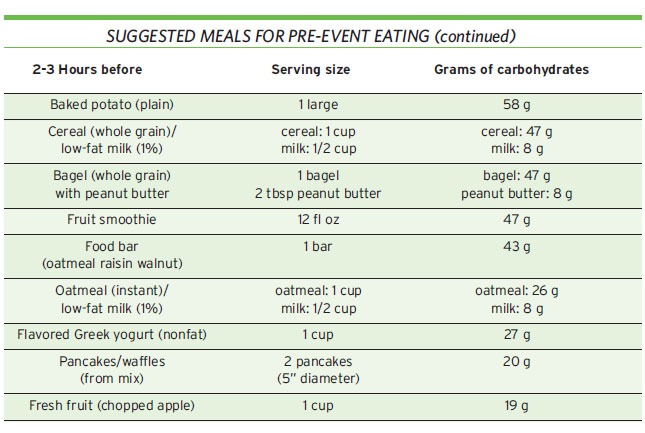
TABLE 2 IMAGE TEXT CONTINUED:
SUGGESTED MEALS FOR PRE-EVENT EATING (continued)
| 2-3 Hours before | Serving size | Grams of carbohydrates |
|---|---|---|
| Baked potato (plain) | 1 large | 58 g |
| Cereal (whole grain)/low-fat milk (1%) | cereal: 1 cup milk: 1/2 cup | cereal: 47 g milk: 8 g |
| Bagel (whole grain) with peanut butter | 1 bagel 2 tbsp peanut butter | bagel: 47 g peanut butter: 8 g |
| Fruit smoothie | 12 fl oz | 47 g |
| Food bar (oatmeal raisin walnut) | 1 bar | 43 g |
| Oatmeal (instant)/low-fat milk (1%) | oatmeal: 1 cup milk: 1/2 cup | oatmeal: 26 g milk: 8 g |
| Flavored Greek yogurt (nonfat) | 1 cup | 27 g |
| Pancakes/waffles (from mix) | 2 pancakes (5" diameter) | 20 g |
| Fresh fruit (chopped apple) | 1 cup | 19 g |
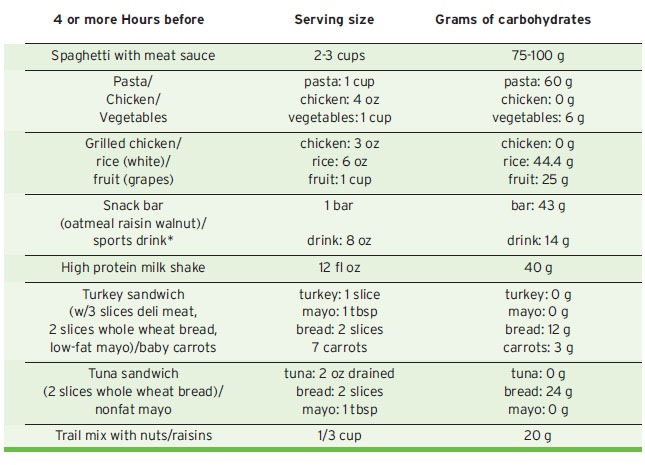
TABLE 2 IMAGE TEXT CONTINUED:
| 4 or more Hours before | Serving size | Grams of carbohydrates |
|---|---|---|
| Spaghetti with meat sauce | 2-3 cups | 75-100 g |
| Pasta/Chicken/Vegetables | pasta: 1 cup chicken: 4 oz vegetables: 1 cup | pasta: 60 g chicken: 0 g vegetables: 6 g |
| Grilled chicken/rice (white)/fruit (grapes) | chicken: 3 oz rice: 6 oz fruit: 1 cup | chicken: 0 g rice: 44.4 g fruit: 25 g |
| Snack bar (oatmeal raisin walenut)/sports drink | 1 bar drink: 8 oz | bar: 43 g drink: 14 g |
| High protein milk shake | 12 fl oz | 40 g |
| Turkey sandwich (w/ 3 slices deli meat, 2 slices whole wheat bread, low-fat mayo)/baby carrots | turkey: 1 slice mayo: 1 tbsp bread: 2 slices 7 carrots | turkey: 0 g mayo: 0 g bread: 12 g carrots: 3 g |
| Tuna sandwich (2 slices whole wheat bread)/nonfat mayo | tuna: 2 oz drained bread: 2 slices mayo: 1 tbsp | tuna: 0 g bread: 24 g mayo: 0 g |
| Trail mix with nuts/raisins | 1/3 cup | 20 g |
*Remember that sports drinks are beverages that contain electrolytes and carbohydrates, not caffeine and other stimulants. For more information on sports drinks and hydration, read the Fluids and Hydration section.
Eating at All Day Events:
It is important that athletes eat after competing to make sure that they will have enough energy in the muscles for the next race or competition, whether it be in the same day or the following days. The same dietary intake principles used to plan the pre-exercise meal can also apply to foods eaten at all-day events. If an athlete races at 10:00 a.m. and again after two hours, foods that are high in protein and fat will more than likely still be in the stomach potentially causing stomach or gastrointestinal (GI) distress. The following guidelines have been recommended to help athletes make wise food choices at all-day events.
One hour or less between events or heats:
- Stick with carbohydrates that are in liquid form, such as sports drinks.
- If something solid needs to be eaten, try fruits like oranges, watermelon, cantaloupe, peaches, pears, applesauce, or bananas.
These foods consist of mostly carbohydrates and water. They are digested very fast and therefore, will not cause as much of a problem with stomach cramping or GI distress.
Another key point to making food choices with limited time between events, is limiting the quantity of the food eaten. The more an athlete eats, the longer it will take to digest, especially with any pre-competition nerves or stress.
Two to three hours between events or heats:
- Foods containing carbohydrates and some protein can be eaten, as there is enough time to digest them before competition.
- Try eating granola bars with jerky, hot or cold cereal with nonfat milk, or english muffins along with fruit like bananas, apples, oranges, peaches, or pears.
- Be sure to drink plenty of fluids, like water or a sports drink, for hydration, electrolyte replacement, and restoration of glycogen stores. Avoid drinks that contain caffeine, carbonation, and other stimulants.
Four or more hours between events or heats:
With four or more hours between events or heats, an athlete may want a meal, which should be composed primarily of carbohydrates. Keep the meals simple. The following meal examples for this situation are appropriate:
- A turkey sandwich on two slices of whole wheat bread, Greek yogurt with fruit, and water or a sports (fluid replacement) drink; or
- Spaghetti with lean meatballs, bread, salad with dressing, and water or a sports (fluid replacement) drink.
If there is a certain meal pattern before competition that an athlete thinks is a winning combination, then they should stick to it.
Athletes who make food choices at concession stands need to know how to make the best choices. Most concession stands are filled with high-fat, high-calorie foods that are not designed to maximize performance. It is always wiser for athletes to pack a cooler from home with winning combinations, than to rely on the food at a concession stand. Table 3 has a list of nutrient-dense foods that are easy to pack in a cooler and will help supply energy throughout the day.
During Exercise:
Consuming carbohydrates during exercise lasting longer than 60 minutes ensures that the muscles receive adequate amounts of energy, especially during the later stages of the competition or workout. This has also been found to improve performance. The form of carbohydrates consumed does matter. Some athletes prefer to use a sports drink, whereas others prefer to eat solid or gel forms of carbohydrates. Use the following guidelines when consuming sports drinks with carbohydrates.
- Consume 6 to 12 ounces of a sports drink with 6-8% carbohydrate concentration every 15-30 minutes during exercise (see Table 4). One gulp is about 2 ounces.
- Water is needed to aid in absorption of the carbohydrate. Drinks with a concentration greater than 10 percent are often associated with abdominal cramps, nausea, and diarrhea.
- For high intensity activities, sports drinks and gels containing multiple forms of sugar can increase absorption and delivery of carbohydrates.
Note: Sports drinks should not be confused with “energy” drinks. “Energy” drinks typically contain one or more stimulants and their carbohydrate concentration is usually greater than 10%. Sports drinks are beverages that contain electrolytes and carbohydrates, not caffeine and other stimulants.
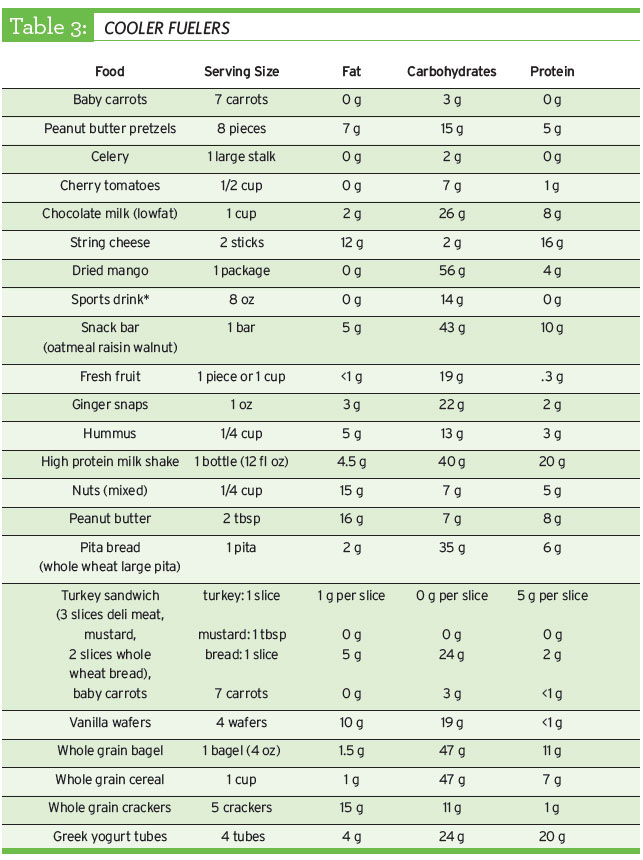
TABLE 3 IMAGE TEXT:
COOLER FLUIDS
| Food | Serving Size | Fat | Carbohydrates | Protein |
|---|---|---|---|---|
| Baby carrots | 7 carrots | 0 g | 3 g | 0 g |
| Peanut butter pretzels | 8 pieces | 7 g | 15 g | 5 g |
| Celery | 1 large stalk | 0 g | 2 g | 0 g |
| Cherry tomatoes | 1/2 cup | 0 g | 7 g | 1 g |
| Chocolate milk (lowfat) | 1 cup | 2 g | 26 g | 8 g |
| String cheese | 2 sticks | 12 g | 2 g | 16 g |
| Dried mango | 1 package | 0 g | 56 g | 4 g |
| Sports drink | 8 oz | 0 g | 14 g | 0 g |
| Snack bar (oatmeal raisin walnut) | 1 bar | 5 g | 43 g | 10 g |
| Fresh fruit | 1 piece or 1 cup | <1 g | 19 g | .3 g |
| Ginger snaps | 1 oz | 3 g | 22 g | 2 g |
| Hummus | 1/4 cup | 5 g | 13 g | 3 g |
| High protein milk shake | 1 bottle (12 fl oz) | 4.5 g | 40 g | 20 g |
| Nuts (mixed) | 1/4 cup | 15 g | 7 g | 5 g |
| Peanut butter | 2 tbsp | 16 g | 7 g | 5 g |
| Pita bread (whole wheat large pita) | 1 pita | 2 g | 35 g | 6 g |
| Turkey sandwich (3 slices deli meat, mustard, 2 slices whole wheat bread), baby carrots | turkey: 1 slice mustard: 1 tbsp bread: 1 slice 7 carrots | 1 g per slice 0 g 5 g 0 g | 0 g 0 g per slice 24 g 3 g | 5 g per slice 0 g 2 g <1 g |
| Vanilla wafers | 4 wafers | 10 g | 19 g | <1 g |
| Whole grain bagel | 1 bagel (4 oz) | 1.5 g | 47 g | 11 g |
| Whole grain cereal | 1 cup | 1 g | 47 g | 7 g |
| Whole grain crackers | 5 crackers | 15 g | 11 g | 1 g |
| Greek yogurt tubes | 4 tubes | 4 g | 24 g | 20 g |
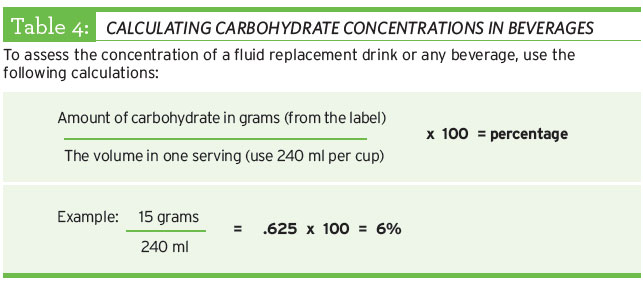
TABLE 4 IMAGE TEXT:
CALCULATING CARBOHYDRATE CONCENTRATIONS IN BEVERAGES.
To asses the concentration of a fluid replacement drink or any beverage, use the following calculations:
Amount of carbohydrate in grams (from the label) divded by the volume in one serving (use 240 ml per cup), time 100 = the percentage.
Remember that sports drinks are beverages that contain electrolytes and carbohydrates, not caffeine and other stimulants. For more information on sports drinks and hydration, read the Fluids and Hydration section.
After Exercise
Consuming a carbohydrate snack as soon as possible after training will allow the body to start replenishing glycogen stores in the body. Additionally, consuming a couple of mixed meals high in carbohydrates within six hours after training or a competition ensures that the muscles continue with glycogen restoration.
- Athletes who may benefit from recovery nutrition include those who are competing in tournament play or have multiple competitions over the course of one or several days, have skipped meals throughout the day, did not consume enough calories, and want to improve strength and power.
- The recommendation is 1-1.2 grams of carbohydrates per kilogram of body weight per hour for the first four hours after exercise. Refueling may be enhanced by consuming small amounts of carbohydrate more frequently (every 15-30 minutes) for up to four hours.
- Add a small amount (~20 grams) of protein to the first feeding to stimulate muscle repair and rebuilding.
- Table 5 and 6 list recovery tips and examples of recovery snacks.
TABLE 5 IMAGE TEXT:
POST-EXERCISE RECOVERY TIPS
- To refill energy in the muscle with trainings less than eight hours apart, eat as soon as possible after exercise and then every 15-30 minutes for up to four hours.
- Choose higher-carbohydrate foods such as bagels, pasta, fruits, yogurts, cereal with low-fat milk, peanut butter, sports drinks, granola bars, french toast, sub sandwiches, baked potatoes with chili, smoothie made with fruit, fruit juice, yogurt, and frozen yogurt.
- Include protein to aid in muscle recovery and promote muscle growth.
- If you can’t consume solid foods as soon as possible after exercise, try 2-4 cups of a sports drink, then consume solid food within four hours post-exercise.
- Consume 1-1.2 g of carbohydrates per kilogram body weight per hour for the first four hours after glycogen-depleting exercise. Be sure to rehydrate as well.
Read the full Nutrition Guide and learn more about how to get peak performance with optimal nutrition.




